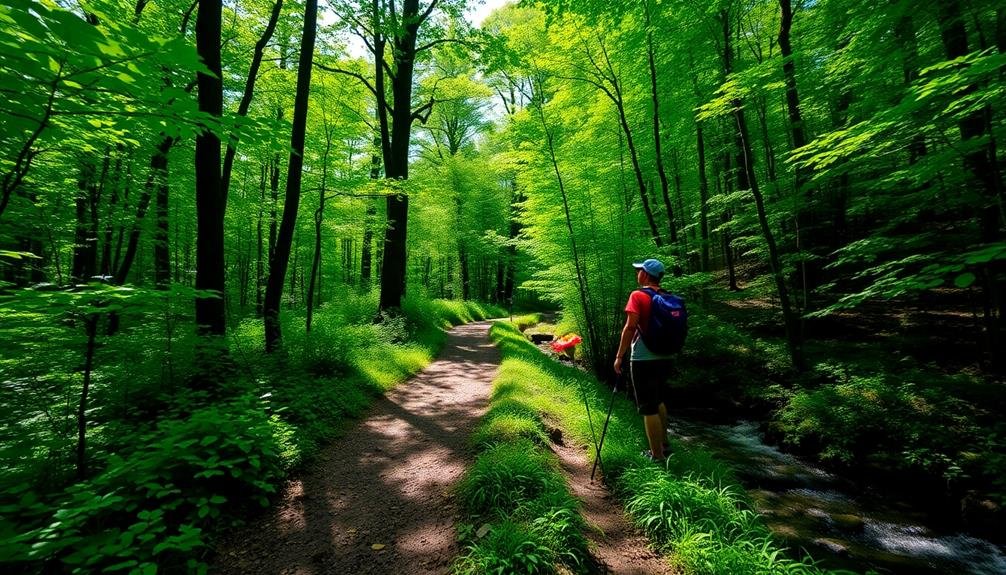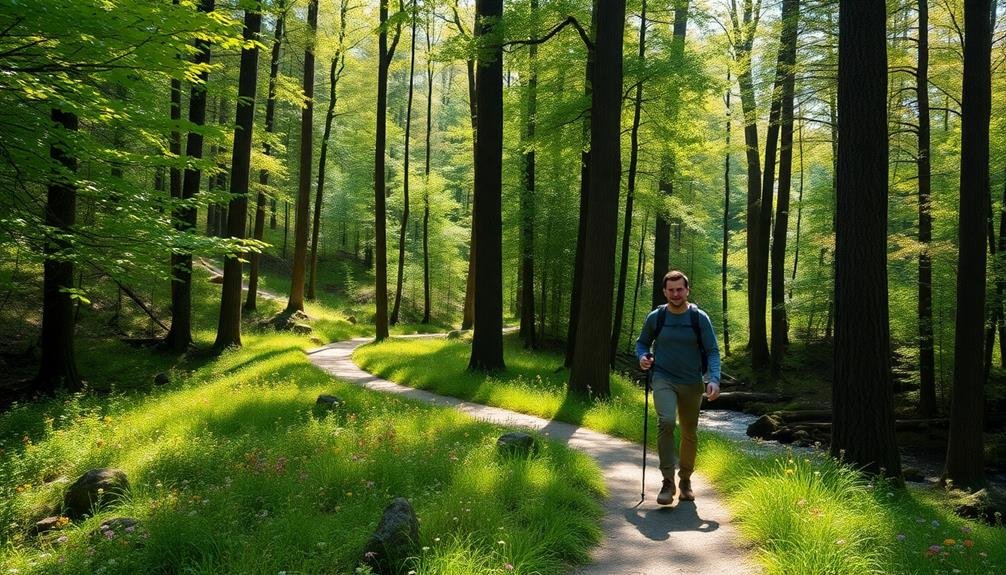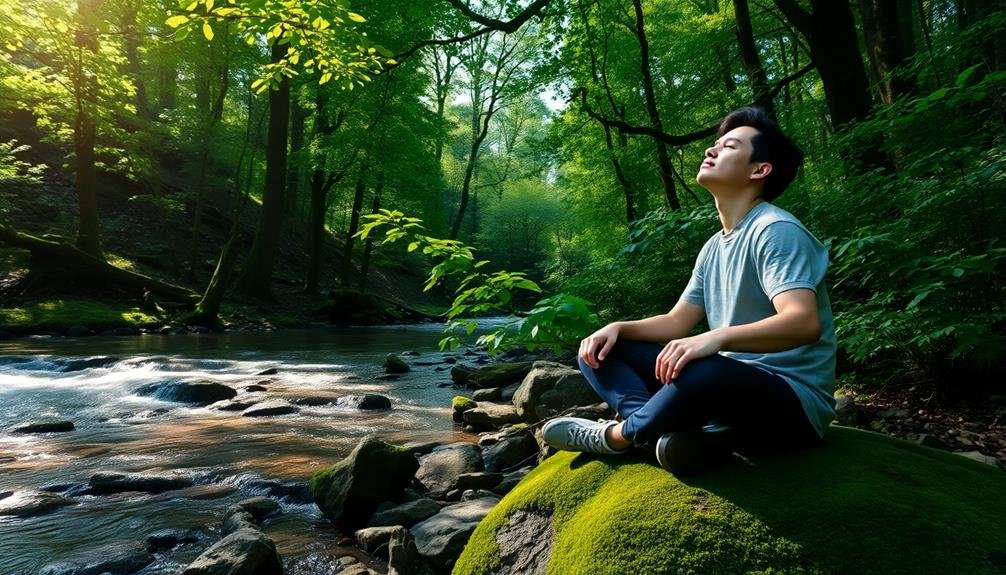Hiking can be a calming escape for anxious beginners. Start by choosing trails that match your fitness level and avoid crowded areas. Practice deep breathing; inhale deeply, hold, then exhale slowly to ease your mind. Engage your senses—admire the vibrant colors and listen to nature's soothing sounds. Set a comfortable pace; take breaks when needed, and use grounding techniques to stay present. Visualize calming images to enhance relaxation. After your hike, reflect on your feelings and experiences. These techniques will help you connect with nature and promote a sense of peace while you explore new trails ahead.
Choose the Right Trail

Choosing the right trail is essential for easing anxiety during your hike. Start by considering your fitness level and experience. If you're new to hiking, opt for well-marked, shorter trails with gentle elevation changes. These paths provide a sense of security and help you build confidence in your abilities.
Next, think about the surroundings. A trail that offers beautiful views, natural sounds, and a serene atmosphere can greatly enhance your experience. Research local trails to find ones that resonate with you and make you feel comfortable. Avoid crowded areas, as large groups can heighten feelings of anxiety.
Pay attention to the weather, too. Choose a day with mild temperatures and clear skies, as this can impact your mood and comfort level. Early morning or late afternoon hikes often provide a quieter experience, allowing you to connect more deeply with nature.
Lastly, familiarize yourself with the trail beforehand. Knowing what to expect can help alleviate worries. Bring a trusted companion if it makes you feel more at ease, and remember that it's perfectly fine to turn back if you feel overwhelmed.
Choosing the right trail is a key step to enjoying a calming, fulfilling hiking experience.
Practice Deep Breathing
Deep breathing is a powerful technique that can help calm your nerves before and during your hike. When anxiety hits, your breathing often becomes shallow and rapid, which can heighten your feelings of stress. By intentionally focusing on your breath, you can regain control and create a sense of calm.
Start by finding a comfortable position, whether you're standing still or sitting on a rock. Inhale deeply through your nose, allowing your abdomen to expand fully. Hold that breath for a moment, and then exhale slowly through your mouth. Aim for a count of four while inhaling, holding for four, and exhaling for six.
Repeat this cycle several times, and you'll likely notice your heart rate slowing and your body relaxing.
Whenever you feel anxious on your hike, take a moment to practice deep breathing. It's a simple yet effective way to ground yourself.
You can even combine deep breathing with movement; try inhaling as you take a step and exhaling as you place your foot down. This rhythmic breathing can enhance your connection to the trail, making your hike more enjoyable and less stressful.
Focus on Your Surroundings

As you hike, take a moment to listen to the soothing sounds of nature around you—whether it's the rustling leaves or a distant bird call.
These sounds can ground you and bring a sense of calm.
Plus, focusing on the vibrant colors and intricate details of your surroundings helps shift your mind away from anxiety.
Nature's Soothing Sounds
While you hike, tuning into nature's soothing sounds can transform your experience and ease anxiety. By focusing on the auditory elements surrounding you, you'll create a calming atmosphere that helps ground your thoughts and feelings.
Here are some sounds to listen for during your hike:
- Birdsong: The cheerful melodies of birds can uplift your spirits and remind you of nature's beauty.
- Rustling Leaves: The gentle whisper of leaves in the breeze can provide a sense of peace and connection to the earth.
- Flowing Water: The sound of a nearby stream or river can evoke tranquility and encourage mindfulness.
- Insects Buzzing: The hum of bees or crickets can create a comforting background noise, reminding you of the vibrant ecosystem.
- Wind Chimes of Nature: The varied sounds of wind through trees can soothe your mind and help clear your thoughts.
As you immerse yourself in these natural symphonies, you'll find your worries begin to fade.
Embrace this auditory experience, letting it guide you toward a more peaceful state of mind as you hike.
Visual Appreciation Techniques
Many beginners overlook the power of visual appreciation during a hike, but focusing on your surroundings can greatly enhance your experience. By consciously observing the beauty around you, you'll cultivate mindfulness and help ease anxiety.
Start by taking a moment to look up at the sky. Notice the colors, the clouds, and how the light changes as you walk. Then, shift your gaze to the ground. Observe the textures of the soil, leaves, and any small creatures scurrying about.
To help guide your observations, consider using the table below:
| Element | What to Observe | Benefits |
|---|---|---|
| Sky | Cloud shapes, colors | Promotes relaxation |
| Flora | Plant types, colors | Enhances connection to nature |
| Wildlife | Birds, insects, animals | Boosts mood and reduces stress |
As you hike, consciously engage with these elements. This practice not only distracts from anxious thoughts but also deepens your appreciation for nature. So, take a moment, breathe deeply, and let your surroundings envelop you in tranquility.
Use Grounding Techniques
Grounding techniques can be a powerful tool for anxious beginners on the trail. These methods help you stay present, reducing overwhelming feelings and enhancing your hiking experience. When anxiety creeps in, you can anchor yourself to the environment and regain control.
Here are five effective grounding techniques to try:
- Focus on Your Senses: Take a moment to notice what you see, hear, feel, and smell around you. Engaging your senses pulls you back to the present.
- Feel the Ground: Pay attention to your feet connecting with the earth. Notice the texture of the trail beneath you, whether it's rocky, muddy, or smooth.
- Breathing Exercises: Take deep, intentional breaths. Inhale through your nose for a count of four, hold for four, then exhale through your mouth for another four.
- Count Objects: Pick a color and count how many objects of that color you see along the trail. This keeps your mind focused and distracts from anxious thoughts.
- Practice Gratitude: Reflect on what you appreciate about the hike. This shifts your mindset and fosters positive feelings.
Implement these techniques to enhance your comfort and confidence on the trail!
Set a Comfortable Pace

Finding your comfortable pace is essential for a positive hiking experience, especially if you're feeling anxious. When you set a pace that feels right for you, it allows you to enjoy the scenery without feeling overwhelmed.
Start by paying attention to your breath. If you find it's becoming rapid or uneven, slow down. It's perfectly okay to take breaks; they can help you regroup and recharge.
Notice the terrain around you. If the trail gets steeper or rockier, adjust your speed accordingly. You don't have to keep up with others; focus on your own rhythm instead. Enjoy the process of hiking rather than pushing yourself to meet an unrealistic goal.
You might also want to use a hiking app or watch to monitor your pace. This way, you can set a target that feels comfortable and achievable. Remember, it's about enjoying nature and finding peace as you walk.
As you hike, listen to your body. If you're feeling fatigued or anxious, don't hesitate to pause or turn back. The journey should be enjoyable, and setting a comfortable pace will help you achieve that.
Incorporate Mindful Walking
As you hike, focus on your breath to create a calming rhythm that keeps anxiety at bay.
Engage your senses by noticing the colors, textures, and smells around you, allowing the environment to ground you in the moment.
Embrace nature's sounds, whether it's rustling leaves or chirping birds, to further enhance your connection with the peaceful surroundings.
Focus on Your Breath
Breathing deeply can transform your hiking experience, especially when anxiety creeps in. When you focus on your breath, you anchor yourself in the moment, making it easier to let go of distractions and worries.
Here's how to incorporate mindful breathing into your hike:
- Find a rhythm: Match your breath to your steps, inhaling for a count of four, holding for a count of two, and exhaling for a count of six.
- Use your nose: Inhale through your nose to engage your diaphragm, which promotes deeper, more calming breaths.
- Visualize your breath: Imagine your breath flowing in and out like the gentle ebb and flow of a tide, bringing calm with each inhale and releasing tension with every exhale.
- Focus on the present: If your mind starts to wander, gently bring your attention back to your breath and the sensations in your body as you walk.
- Practice regularly: The more you practice mindful breathing on the trail, the more natural it becomes, helping you manage anxiety effectively.
Engage Your Senses
Immerse yourself in the beauty around you by engaging your senses while hiking. Start by noticing the vibrant colors of the leaves, the varying shades of green, or the delicate petals of wildflowers. Let your eyes wander and appreciate the intricate details that nature offers.
Next, focus on the textures beneath your fingertips. Touch the rough bark of a tree, the soft petals of a flower, or the cool, smooth stones along the path. This tactile connection grounds you in the moment, allowing your worries to fade away.
As you walk, pay attention to the scents surrounding you. Breathe in the fresh, earthy aroma of the forest, or the sweet scent of blooming flowers. Let these fragrances anchor you, reminding you of the beauty of the present.
Embrace Nature's Sounds
Listening to the world around you enhances your hiking experience, creating a soothing soundtrack that calms your mind.
As you walk, take a moment to tune in to the sounds of nature. These auditory elements can ground you, helping to reduce anxiety and foster a deeper connection with your surroundings.
To make the most of this experience, try these mindful walking techniques:
- Focus on the rustling leaves: Notice how they dance with the wind, creating a gentle whisper.
- Listen for bird calls: Different species have unique songs, adding layers to your auditory landscape.
- Feel the crunch of the trail underfoot: Each step can be a reminder of your presence in nature.
- Pay attention to flowing water: The sound of a nearby stream can be incredibly calming.
- Breathe in the silence: In quieter areas, take a moment to appreciate the absence of noise.
Listen to Nature Sounds

How often do you take a moment to truly soak in the sounds around you while hiking? When you immerse yourself in nature's symphony, you can markedly reduce anxiety and enhance your experience.
Start by focusing on the rustling leaves, birds chirping, and the gentle flow of nearby streams. These sounds create a calming backdrop that can ground you in the present moment.
Try to identify each sound. Is that the call of a blue jay? The soft whisper of the wind? Engaging your auditory senses not only distracts you from anxious thoughts but also helps you connect with the environment.
Consider taking a few deep breaths as you listen, allowing the natural rhythm to soothe your mind.
If you find your thoughts drifting back to worries, gently redirect your focus to the sounds around you. Tune into the variations in pitch and volume. You might even find that certain sounds resonate with you more than others, offering a unique sense of comfort.
Engage With Nature
As you hike, take a moment to observe the wildlife around you; it can be both calming and fascinating.
Breathe in the fresh air, allowing it to clear your mind and soothe your nerves.
Let the natural sounds envelop you, creating a peaceful connection with the environment.
Observe Surrounding Wildlife
Nature is alive with movement and sound, offering a rich tapestry of wildlife to observe during your hike. Engaging with the animals and plants around you can be incredibly calming and grounding.
As you walk, take a moment to slow down, tune in, and really look at your surroundings. Here are a few things you might notice:
- Colorful birds flitting between branches, their songs filling the air.
- Squirrels darting playfully around trees, showcasing their acrobatic skills.
- Butterflies gracefully landing on flowers, adding splashes of color to your path.
- Insects buzzing about, playing their part in the ecosystem.
- Small mammals like rabbits or deer peeking out from behind bushes, reminding you of the beauty of wildlife.
Breathe in Fresh Air
While you hike, taking deep breaths of fresh air can greatly enhance your experience and help ease anxiety. The crisp, clean air fills your lungs, providing a rejuvenating contrast to the stuffiness of daily life. As you inhale, focus on the sensation of the air entering your body, grounding you in the present moment. This simple act can shift your mindset and calm racing thoughts.
Notice the scent of pine trees, wildflowers, or damp earth as you breathe in. Each breath connects you deeper to your surroundings, reminding you that nature has a soothing power. When you feel anxiety creeping in, pause and take a few moments to breathe intentionally. Inhale deeply through your nose, hold it for a moment, and exhale slowly through your mouth.
This practice not only helps alleviate anxiety but also promotes mindfulness. You'll become more aware of your body and the beauty around you. Allow the fresh air to invigorate your spirit and create a sense of clarity.
Engaging with nature in this way transforms your hike into a revitalizing escape, renewing both your mind and body. So, embrace the fresh air and let it work its magic.
Connect With Natural Sounds
After embracing the fresh air, tune into the natural sounds surrounding you. Engaging with these soothing auditory elements can greatly calm your anxious mind. By focusing on what you hear, you'll create a deeper connection with nature, allowing stress to melt away.
Here are some sounds to listen for:
- Rustling leaves: The gentle movement of leaves can offer a rhythmic backdrop.
- Birdsong: The melodies of birds can uplift your spirit and bring a sense of joy.
- Flowing water: Whether it's a stream or a waterfall, the sound of water can be incredibly calming.
- Wind whispering: The soft whoosh of wind through trees can evoke a sense of peace.
- Distant wildlife: The occasional call of animals can remind you of nature's vibrant ecosystem.
As you walk, let these sounds envelop you. Feel the tension in your body dissolve with each note.
This mindful listening practice not only grounds you in the moment but also enhances your overall hiking experience.
Visualize Calmness

Imagine yourself on a serene trail, surrounded by the soft rustle of leaves and the gentle whisper of the wind. As you walk, take a moment to visualize calmness enveloping you.
Picture a warm, glowing light radiating from within, slowly expanding to fill your entire being. With each step, imagine this light growing stronger, pushing away any feelings of anxiety or tension.
Focus on your breath, inhaling deeply and exhaling slowly. As you breathe in, visualize the fresh, clean air entering your lungs, bringing with it peace and tranquility.
As you exhale, imagine releasing all your worries and fears into the atmosphere, watching them dissipate into the air like mist.
You can also visualize a peaceful scene—perhaps a tranquil lake or a quiet meadow bathed in sunlight. Picture yourself there, feeling safe and relaxed.
Allow this image to ground you, reminding you that calmness is always within reach.
Keep returning to this visualization whenever stress arises during your hike. Each time you connect with this mental image, it'll reinforce your sense of calm, helping you enjoy the beauty of your surroundings more fully.
Reflect After Your Hike
How can reflecting on your hike enhance your overall experience? Taking a moment to think back on your journey can deepen your connection to nature and help you process your feelings.
It's an opportunity to appreciate the beauty you encountered and the personal challenges you faced. Here's how you can make the most of your reflection time:
- Recall Your Feelings: What emotions arose during your hike? Joy, peace, or perhaps anxiety? Acknowledge them.
- Identify Challenges: Did you face any obstacles? Consider how you overcame them and what you learned.
- Celebrate Achievements: Recognize the effort you put in. Completing a hike is an accomplishment, no matter the distance.
- Visualize Moments: Picture the stunning views or serene spots that stood out. This can enhance your appreciation for nature.
- Plan for the Future: Think about what you'd like to do next time. Maybe a new trail or a different time of year?
Frequently Asked Questions
What Should I Wear for a Calming Hiking Experience?
For a calming hiking experience, wear comfortable, moisture-wicking clothes to keep you cool and dry. Choose supportive footwear and layered clothing to adapt to changing weather. Don't forget a hat and sunscreen for protection!
How Do I Choose the Right Hiking Gear for Anxiety?
Choosing the right hiking gear for anxiety starts with comfort. Opt for breathable fabrics, supportive footwear, and layers. Make certain your pack fits well, and don't forget essentials like water and snacks to stay energized.
Can I Hike Alone if I Feel Anxious?
Yes, you can hike alone if you feel anxious. Start with shorter trails, establish familiar routes, and bring comforting items. Trust your instincts, listen to your body, and remember it's okay to take breaks.
What Are Some Calming Snacks to Bring on My Hike?
When you're hiking, pack calming snacks like nuts, dark chocolate, or dried fruit. They'll fuel your energy and soothe your mind. Staying nourished helps you focus on the beauty around you, reducing anxiety. Enjoy your hike!
How Can I Prepare Mentally Before My Hike?
Before your hike, visualize the journey, focus on your breathing, and set positive intentions. Remind yourself it's okay to take breaks, and trust that you've got the skills to enjoy the adventure ahead.
In Summary
By incorporating these calming hiking techniques, you can transform your outdoor experience into a peaceful retreat. Choosing the right trail, practicing deep breathing, and engaging with nature will help ease your anxiety. Remember to set a comfortable pace and reflect on your journey afterward. Embrace the sights and sounds around you, and don't hesitate to visualize calmness whenever you feel overwhelmed. You've got this—hiking can be a wonderful way to find tranquility in nature!





Leave a Reply